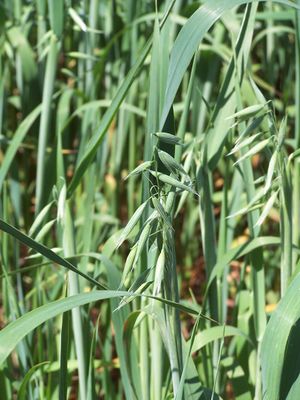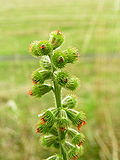Note: This is a project under development. The articles on this wiki are just being initiated and broadly incomplete. You can Help creating new pages.
Difference between revisions of "Avena sativa - Oat"
m (Prabhakar moved page Oat (Avena sativa) to Avena sativa - Oat) |
|||
| Line 1: | Line 1: | ||
| + | {{stub}} | ||
| + | |||
[[File:Avena sativa L.jpg|thumb|right|''Oat'']] | [[File:Avena sativa L.jpg|thumb|right|''Oat'']] | ||
| − | The '''oat''' | + | The '''oat''' (Avena sativa), sometimes called the common oat, is a species of cereal grain grown for its seed, which is known by the same name (usually in the plural, unlike other cereals and pseudocereals). While oats are suitable for human consumption as oatmeal and rolled oats, one of the most common uses is as livestock feed. |
| + | |||
| + | ==Uses== | ||
| + | {{Uses|Wounds}}, {{Uses|Cuts}}, {{Uses|Snakebites}}, {{Uses|Curing liver disorders}}, {{Uses|Skin eruptions}}, {{Uses|Blotches}}, {{Uses|Pimples}}, {{Uses|Diarrhea}}, {{Uses|Sore throats}} | ||
| + | |||
| + | ==Parts Used== | ||
| + | {{Parts Used|Seeds}}. | ||
| + | |||
| + | ==Chemical Composition== | ||
| + | Per 100 g, the mature seed is reported to contain 374 calories, 11.0 g H20, 13.1 g protein, 6.1 g fat, 67.4 g total carbohydrate, 5.8 g fiber, 2.4 g ash, 59 mg Ca, 425 mg P, 4.6 mg Fe, 10 mg Na, 0.35 mg thiamine, 0.09 mg riboflavin, and 2.2 mg niacin. Generically, oat grains, with 78.7–95.2% DM (mean of 1650 cases = 89.1), contain on a zero moisture basis<ref name="chemical composition"/> | ||
| − | + | ==Common names== | |
| − | + | {{Common names|kn=|ml=|sa=|ta=|te=|hi=|en=Agrimony}} | |
| − | |||
| − | + | ==Habit== | |
| − | + | {{Habit|Culms erect}} | |
| − | |||
| − | + | ==Identification== | |
| − | + | ===Leaf=== | |
| + | {{Leaf|Simple|cauline|Ligule an eciliate membrane; 3-6 mm long. Leaf-blades 14-40 cm long 5-15 mm wide and Leaf-blade surface scaberulous}}<ref name="Leaf"/> | ||
| − | + | ===Flower=== | |
| − | + | {{Flower|Unisexual|2-4cm long|Yellow|5-20|Ovary pubescent all over and Flowers Season is June - August}} | |
| − | + | ===Fruit=== | |
| + | {{Fruit|Caryopsis||Caryopsis with adherent pericarp; hairy all over. Hilum linear|hairy all over|few seeds}} | ||
| − | == | + | ===Other features=== |
| − | * ''' | + | ==List of Ayurvedic medicine in which the herb is used== |
| + | * [[Vishatinduka Taila]] as ''root juice extract'' | ||
| − | == References == | + | ==Where to get the saplings== |
| + | ==Mode of Propagation== | ||
| + | {{Propagation|Seeds}}, {{Propagation|Dry wasteland}}, {{Propagation|cultivated ground and meadows}} | ||
| + | |||
| + | ==How to plant/cultivate== | ||
| + | Oats are an easily grown crop that succeeds in any moderately fertile soil in full sun<ref name="How to plant/cultivate"/> | ||
| + | |||
| + | ==Commonly seen growing in areas== | ||
| + | {{Commonly seen| Cultivated Beds}}. | ||
| + | ==Photo Gallery== | ||
| + | <gallery class="left" caption="" widths="140px" heights="140px"> | ||
| + | File:Odermennig.jpg | ||
| + | File:Agrimonia eupatoria02.jpg | ||
| + | Image:Agrimonia eupatoria MHNT.BOT.2004.0.jpg | ||
| + | </gallery> | ||
| + | |||
| + | ==References== | ||
<references> | <references> | ||
| − | <ref name=" | + | <ref name="chemical composition">[https://hort.purdue.edu/newcrop/duke_energy/Avena_sativa.html "purdue university"]</ref> |
| + | |||
| + | <ref name="Leaf">[http://powo.science.kew.org/taxon/urn:lsid:ipni.org:names:391732-1 "kew science"]</ref> | ||
| + | |||
| + | <ref name="How to plant/cultivate">[https://www.pfaf.org/user/Plant.aspx?LatinName=Avena+sativa "palnts for future"]</ref> | ||
</references> | </references> | ||
| + | |||
| + | ==External Links== | ||
| + | |||
[[Category:Herbs]] | [[Category:Herbs]] | ||
Revision as of 10:59, 25 April 2018
The oat (Avena sativa), sometimes called the common oat, is a species of cereal grain grown for its seed, which is known by the same name (usually in the plural, unlike other cereals and pseudocereals). While oats are suitable for human consumption as oatmeal and rolled oats, one of the most common uses is as livestock feed.
Contents
[hide]Uses
Wounds, Cuts, Snakebites, Curing liver disorders, Skin eruptions, Blotches, Pimples, Diarrhea, Sore throats
Parts Used
Chemical Composition
Per 100 g, the mature seed is reported to contain 374 calories, 11.0 g H20, 13.1 g protein, 6.1 g fat, 67.4 g total carbohydrate, 5.8 g fiber, 2.4 g ash, 59 mg Ca, 425 mg P, 4.6 mg Fe, 10 mg Na, 0.35 mg thiamine, 0.09 mg riboflavin, and 2.2 mg niacin. Generically, oat grains, with 78.7–95.2% DM (mean of 1650 cases = 89.1), contain on a zero moisture basis[1]
Common names
| Language | Common name |
|---|---|
| Kannada | |
| Hindi | |
| Malayalam | |
| Tamil | |
| Telugu | |
| Marathi | NA |
| Gujarathi | NA |
| Punjabi | NA |
| Kashmiri | NA |
| Sanskrit | |
| English | Agrimony |
Habit
Identification
Leaf
| Kind | Shape | Feature |
|---|---|---|
| Simple | cauline | Ligule an eciliate membrane; 3-6 mm long. Leaf-blades 14-40 cm long 5-15 mm wide and Leaf-blade surface scaberulous |
Flower
| Type | Size | Color and composition | Stamen | More information |
|---|---|---|---|---|
| Unisexual | 2-4cm long | Yellow | 5-20 | Ovary pubescent all over and Flowers Season is June - August |
Fruit
| Type | Size | Mass | Appearance | Seeds | More information |
|---|---|---|---|---|---|
| Caryopsis | Caryopsis with adherent pericarp; hairy all over. Hilum linear | hairy all over | few seeds | {{{6}}} |
Other features
List of Ayurvedic medicine in which the herb is used
- Vishatinduka Taila as root juice extract
Where to get the saplings
Mode of Propagation
Seeds, Dry wasteland, cultivated ground and meadows
How to plant/cultivate
Oats are an easily grown crop that succeeds in any moderately fertile soil in full sun[3]
Commonly seen growing in areas
Photo Gallery
References
External Links
- Pages that are stubs
- Ayurvedic Herbs known to be helpful to treat Wounds
- Ayurvedic Herbs known to be helpful to treat Cuts
- Ayurvedic Herbs known to be helpful to treat Snakebites
- Ayurvedic Herbs known to be helpful to treat Curing liver disorders
- Ayurvedic Herbs known to be helpful to treat Skin eruptions
- Ayurvedic Herbs known to be helpful to treat Blotches
- Ayurvedic Herbs known to be helpful to treat Pimples
- Ayurvedic Herbs known to be helpful to treat Diarrhea
- Ayurvedic Herbs known to be helpful to treat Sore throats
- Herbs with Seeds used in medicine
- Herbs with common name in English
- Habit - Culms erect
- Index of Plants which can be propagated by Seeds
- Index of Plants which can be propagated by Dry wasteland
- Index of Plants which can be propagated by cultivated ground and meadows
- Herbs that are commonly seen in the region of Cultivated Beds
- Herbs



